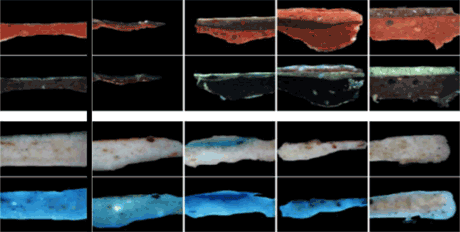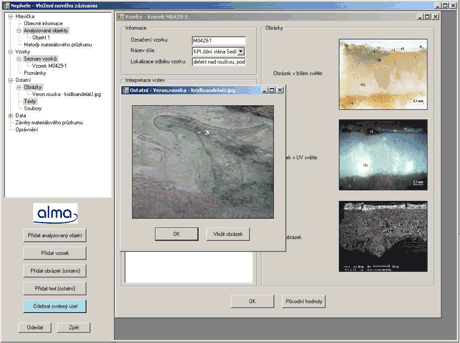by Barbara Zitová, Miroslav Beneš and Janka Hradilová
Nephele is a comprehensive information system for processing and archiving data produced in the process of art conservation.
The benefits of using digital image processing in the area of cultural heritage were identified many years ago. New sensors and modern techniques are employed in the study and in conservation of old, and often damaged, artworks. The Nephele project introduced here, focuses on material analysis research and addresses the key issue of the art conservation - identification of the painting materials used.
The Nephele system was designed for archiving and use of material research reports. To art conservators, it offers better access to the archived material reports they use. Furthermore, its internally implemented methods for image data processing improve the outcome of data analyses and the functioning of the database. Its image retrieval system offers report retrieval based on visual similarity of studied samples. This feature eases the complicated task of retrieval of relevant experience from previous conservation cases. Such a database with a broad spectrum of reports can serve as a knowledge base for future actions.
The Nephele project is realized in close cooperation between the experts from the Institute of Information Theory and Automation, the Academy of Sciences of CR, and from the Academic Materials Research Laboratory for Painted Artworks, joint site of the Academy of Fine Arts and Institute of Inorganic Chemistry, also belonging to the Academy of Sciences of CR. All organizations are located in Prague, Czech Republic. In addition to this tight partnership, we are also incorporating suggestions and ideas from other sources, including laboratories, conservation studios (UK, USA), and conference and workshop discussions. The direct participation of the experts from the cultural heritage area proved to be very important in the development of the tools for the conservators. The project started officially in 2006 and is ongoing.
In general, the functional objectives of the Nephele system can be summarized as follows:
• Archiving – standard database services
• Content based image retrieval
• Sample preprocessing
• Sample analysis – layer segmentation, layer description and morphology
• Material description
• Material classification.
The Nephele system should serve as an archiving environment with the ability to process material reports. The data is used to interpret painting techniques and to support the choice of proper conservation method and materials. The content of the Nephele extended database reflects the structure of individual reports, which describe the process of material research of given artwork. They contain all acquired information about the object - general information about the artwork and its author, information about samples taken from the artwork, results of chemical analyses, and scanned parts analyzed in different modalities. The implicitly included imaging modalities are microscopic data in visible and ultraviolet light and scanning electron microscope (SEM) data.

Figure 1: Results of the content based image retrieval. The left column contains query specimens; the subsequent columns in the corresponding rows are results of the retrieval in order of their similarity.
The standard database functionality, such as report creation, editing, or saving is upgraded by an image based search function, which fetches the image-wise most similar reports and its usage is often more natural than standard databases for the operator. The content-based image retrieval approach is implemented here (based on co-occurrence matrices and wavelet based descriptors), which compares the query image sample with archived image data (see Figure 1). This functionality is enabled due to the included image processing modules, which go beyond the functionality of ordinary databases and, furthermore, are intensively used in the process of artwork analysis and report creation.
The ultimate aim of the image processing modules is the identification and description of individual material layers. The Nephele system can process multimodal data, which can be consecutively enhanced (denoising, artifact removal, deconvolution), geometrically aligned (mutual information), and, finally, segmented into individual material layers (a feature-based approach). These steps produce set of base structures, which are homogenous and can be further described and analyzed. The indentified structures serve as an input for more sophisticated tasks such as the aforementioned image based retrieval, image fusion, or used material classification. An example of the Nephele system GUI is presented in Figure 2.

Figure 2: An example of the Nephele system GUI.
The Nephele project aims to facilitate the tedious work of art conservators with the use of image processing methods and database technology. The system is still under development, with the described functionality being the final aim of the project. In the long run we want to create a knowledge base of reports for use in future conservation cases. Moreover, as a byproduct of the proposed research, we plan to create a taxonomy of material descriptors.
Link:
http://zoi.utia.cas.cz/nephele.html
Please contact:
Barbara Zitová
Dept. of Image Processing , UTIA - Institute of Information Theory and Automation, Academy of Sciences of the Czech Republic / CRCIM, Czech Republic
Tel: +420 266 052 390
E-mail:
Janka Hradilová, Academy of Fine Arts in Prague, Czech Republic
Tel: +420 233 015 324
E-mail:










